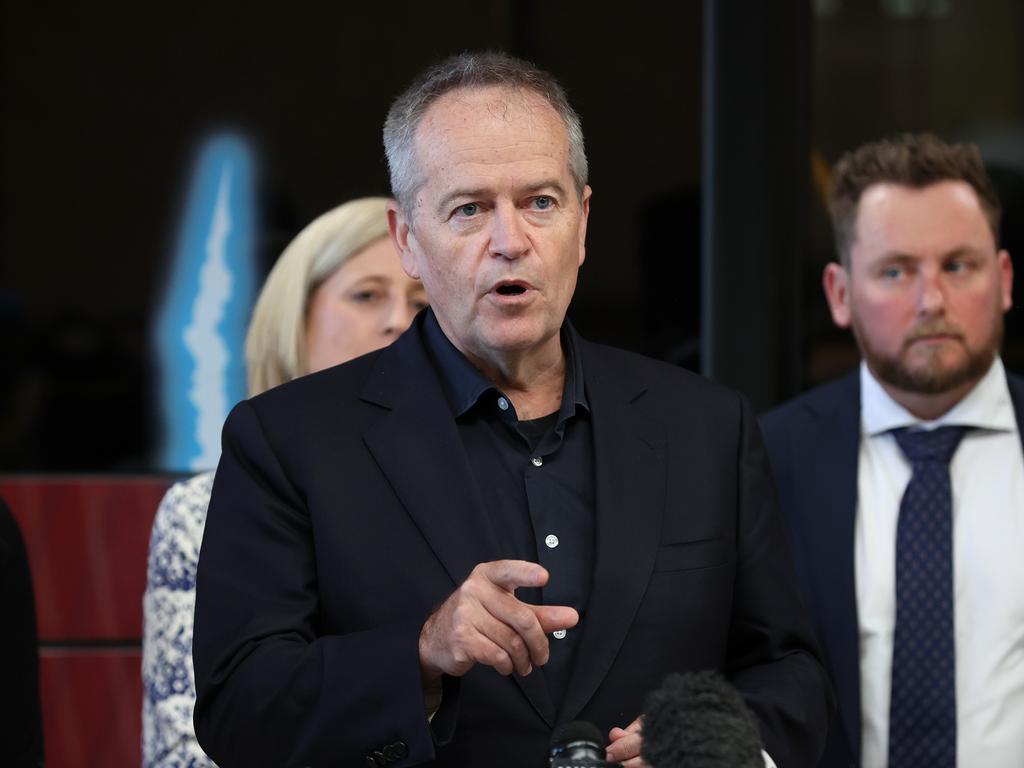Stagflation fears spark shares rout, Philip Lowe warns higher rates needed to tame 7pc inflation
Fears of 1970s stagflation trigger the worst day on the ASX in more than two years as Philip Lowe warns inflation will hit 7pc and admits he’s not sure how high rates may go.

Fears the world is barrelling towards 1970s-style stagflation triggered the worst day on the ASX in more than two years, as frantic selling wiped nearly $100bn from the sharemarket.
Investors are increasingly convinced that central banks will be forced to choke off the post-pandemic global recovery and push unemployment higher in their drive to tame inflation, which is running at multi-decade highs across the developed world.
Beverley Morris, head of fixed income at QIC, which manages $100bn in assets, said markets were arguably moving closer to “panic mode”.
“The number one worry among investors right now is that central banks are behind the curve and will cause a recession in order to bring inflation under control,” Ms Morris said. “We’d say that investors are right to be worried about the prospect of a policy mistake given that history shows that recessions have always followed when the current combination of high inflation and low unemployment has occurred.”
Ms Morris said investors had in large part factored in the higher risk of a recession, but bond market pricing that suggested the official cash rate would push above 4 per cent over the coming 12 months was unrealistic. “We believe that an Australian recession would be almost inevitable if cash rates were to be delivered in line with market pricing,” she said.
Speaking for the first time since last week’s 0.5 percentage point cash-rate hike to 0.85 per cent, the largest move in 22 years, Reserve Bank governor Philip Lowe said “Australians need to be prepared for higher interest rates” and conceded he did not know how high rates may need to go.

“We had emergency settings during the pandemic, I think that was the right thing to do, but the emergency is over,” he told the ABC’s 7.30 program.
“And it’s time to remove the emergency settings and move to more normal settings of monetary policy.”
Dr Lowe said inflation was “too high” but that tightening monetary policy would get it under control by early next year.
“At the moment it’s 5 per cent and by the end of the year I expect inflation to get to 7 per cent,” he said.
“That’s a very high number and we need to be able to chart a course back to 2 per cent to 3 per cent inflation. I’m confident we can do that but it’s going to take time.
“We don’t need to get it back down straight away, we have long had a flexible inflation target in Australia, we can look through the swings and inflation but what we’ve got to do is make sure inflation comes back to 2 to per cent.
“It’s unclear at the moment how far interest rates will need to go up to get that. I’m confident that inflation will come down over time but we will have to have higher interest rates to get that outcome and how much higher remains to be determined”.
Dr Lowe rejected suggestions of a recession, saying he expected the economy to “grow pretty strongly” over the next six to 12 months.
He noted that unemployment was at a 50-year low, households had built up “very large” financial buffers and the number of people falling behind on their mortgages was declining.
“There is still a bounce back from all the Covid restrictions, people are spending in a way they weren’t able to do last year,” he said. “People have got their savings that I’ve talked about to draw on and the current rate of savings is still quite high.
“So, it’s quite plausible that the saving patterns return to where they were before. So even if income growth is a bit weaker people have the financial capacity to keep spending.
“There’s a big backlog of construction work to be undertaken and the number of job vacancies is extraordinarily high.
“So, people can be confident the jobs will be there, and that environment people will keep spending.”
"I think Australians need to be prepared for higher interest rates. We had emergency settings during the pandemic, I think that was the right thing to do, but the emergency is over." – Philip Lowe, RBA Governor #abc730pic.twitter.com/l2KrEPtCjU
— abc730 (@abc730) June 14, 2022
After US consumer price growth was revealed to be increasing at an annual rate of 8.6 per cent, local investors on Tuesday morning responded to another torrid session on Wall Street, sending the All Ordinaries sharemarket index tumbling by as much as 385 points, or 5.4 per cent, in early trade.
Signs of a rebound in New York helped Australian shares rally late in the afternoon, to end the session down 264 points, or 3.7 per cent, to 6881pts. That left the ASX down more than 10 per cent from its peak last August, as all sectors traded lower on the day. Technology stocks led Tuesday’s declines.
The share price of “buy now, pay later” firm Zip plunged 16 per cent. Blue-chip bank and mining stocks also fell, with BHP shares dropping 4.2 per cent, CBA 2.8 per cent and NAB 4.4 per cent. Woodside and Macquarie Group both lost 5.3 per cent.
Climbing wealth has helped underpin the post-pandemic recovery, with the total value of Australian homes passing $10 trillion for the first time in March, according to new ABS stats. That was $3 trillion, or 40 per cent, more than immediately before Covid-19.
But the “wealth effect” that has boosted consumer confidence and spending will turn to a drag
With the US Federal Reserve now expected to hike rates by 0.75 percentage points on Thursday morning, Australian time, investors also dumped government bonds.
The yield on 10-year government debt breached 4 per cent for the first time in eight years, before ending the day 0.28 percentage points higher at 3.96 per cent.

Ahead of a key minimum wage decision by the Fair Work Commission on Wednesday morning, DNR Capital chief investment officer Jamie Nicol said growing evidence that high inflation would persist drove Tuesday’s severe sharemarket sell-off.
“It’s all about inflation, and people are finally capitulating to the idea that inflation is going to be around for longer, and that central banks are going to have to go harder to stop it, which then runs the risk of stagflation – which is the concern,” Mr Nicol said. “Inflation is worse overseas, but if there is inflation everywhere else, it’s only a matter time before we import it.”
Fitch Ratings on Tuesday joined other global organisations such as the World Bank in downgrading the global growth outlook.
“Inflation is not going to fix itself,” Fitch chief economist Brian Coulton said in a report.
“The Fed and Bank of England don’t seem to have much choice now but to take interest rates above neutral, whatever the consequences for growth,” he said.
Revealing a steep cut in the global economic outlook for this year, World Bank president David Malpass said last week: “The war in Ukraine, lockdowns in China, supply-chain disruptions, and the risk of stagflation are hammering growth. For many countries, recession will be hard to avoid.”
Analysts said shareholders had begun to contemplate seriously the end of a 40-year stretch of falling interest rates and inflation – an environment that has been accompanied by ballooning asset valuations, from homes, to stocks, to crypto currencies.
Ms Morris said where inflation would settle was “one of the most important medium-term considerations for investors”.
“We believe we are seeing some signs of stabilisation in global supply chain pressures, which should start to push down on annual inflation rates into next year,” she said.
“However, the many lags in the inflationary process means that it may be a couple of years before we know where inflation will settle.”
JP Morgan Asset Management global market strategist Kerry Craig said it was concerning that investors had rushed so quickly to dump stocks and bonds, adding that the outlook was not as dire as financial markets would suggest.
Mr Craig said he believed the end point for central banks’ key policy rates – 3.25-3.5 per cent in the US and 1.85 per cent in Australia – had not changed but “instead of walking to the final destination, they are starting to run”.
With labour force data on Thursday expected to show that unemployment had ticked down to 3.8 per cent in May, Mr Craig said the economy was “in pretty decent shape” compared with the rest of the world, pointing to a tight labour market and high household savings, which would help cushion cost-of-living pressures.
“The chances of a more material slowdown in the US are absolutely more meaningful," Mr Craig said. “In Europe the economy is flirting with recession, and the UK economy is very weak.
“But the market is telling you right now there will be recession everywhere in the near future, and that‘s not the case.”
As households and businesses face spiking prices from food to fuel, the world will spend $US5.2 trillion more on commodities this year than in 2019, according to Citi research.
This increase would be equivalent to 5 per cent of global GDP – a similar increase to the 1970s oil shock.
The Citi analysts predicted there would be “a prolonged commodity shock”.







To join the conversation, please log in. Don't have an account? Register
Join the conversation, you are commenting as Logout